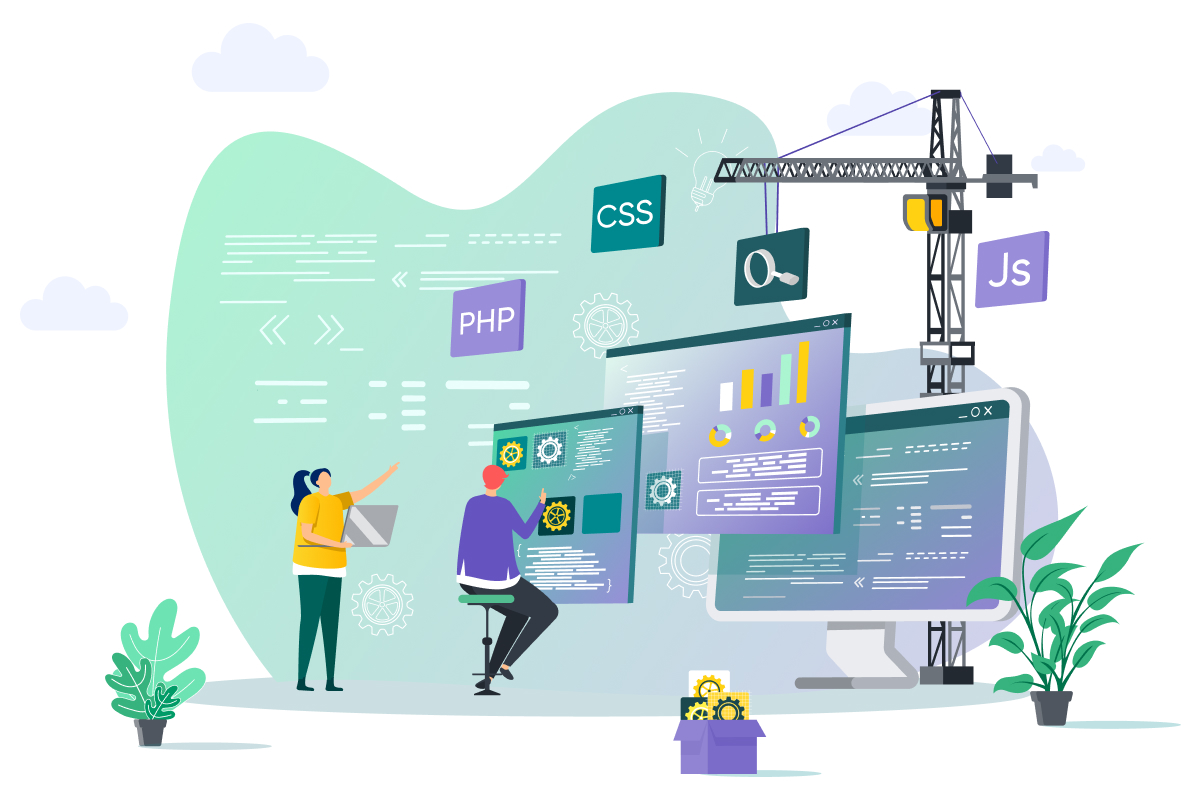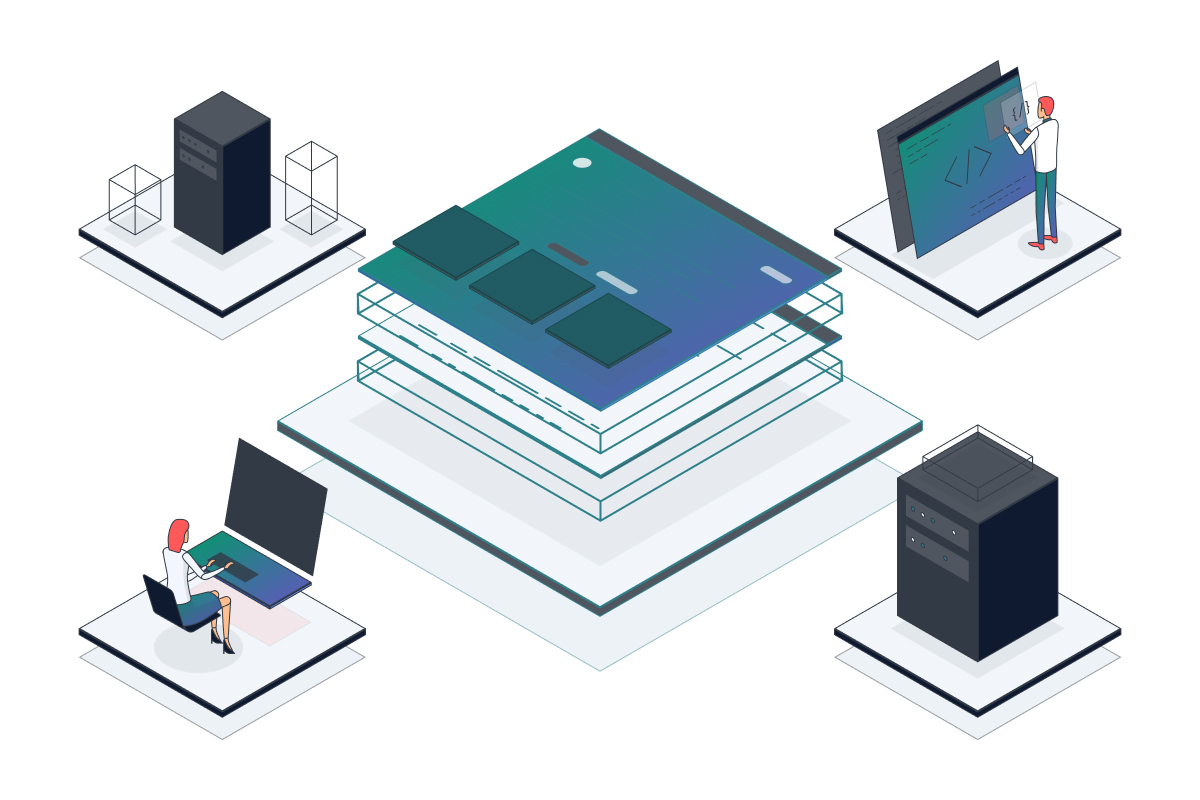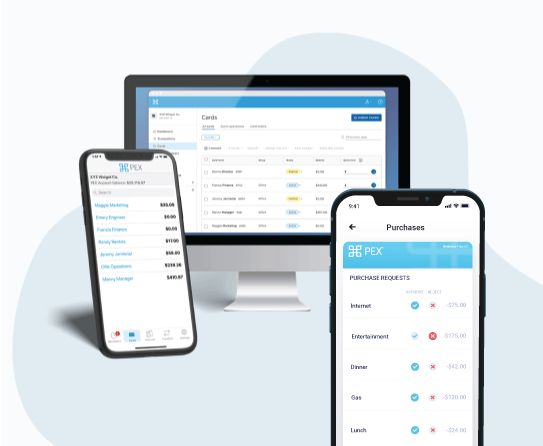Software development has come a long way since its inception. From the early days of punch cards and mainframes to today's dynamic cloud-based applications, the journey of software development mirrors the rapid pace of technological advancement.
The global software market size was estimated at USD 589.6 billion in 2022 and is anticipated to reach around USD 1789.14 billion by 20321, with the number of software developers projected to hit 27.7 million by next year2.
This is in stark contrast to the software development market of the past six decades. As we continue into the mid-2020s, we will see the software development market grow like never before.
Key Takeaways from this Guide:
- Grasp the core principles and methodologies shaping modern software development.
- Understand the roles and dynamics of a contemporary software development team.
- Navigate the challenges and opportunities presented by emerging technologies.

Setting the Stage for a Deep Dive
With the software industry evolving at breakneck speed, staying updated is not just beneficial—it's essential. This guide aims to provide a comprehensive overview, ensuring you're well-equipped to navigate the intricate world of modern software development.
The Evolution of Software: From Humble Beginnings to a Digital Revolution
The 1960s: The Mainframe Era and the Birth of Waterfall
- Mainframes Dominate: Before the advent of personal computers, mainframes were the workhorses of the computing world. Large corporations and institutions relied on these massive machines for their data processing needs.
- Waterfall Methodology: The 1960s saw the conceptualization of the Waterfall model, a linear and sequential approach to software development. Each phase, from requirements gathering to deployment, was completed before moving on to the next, ensuring a structured but rigid process.
- Programming Languages: This decade also witnessed the emergence of foundational programming languages like COBOL and FORTRAN, which played pivotal roles in early software development.

The 1980s & 1990s: The Personal Computer Revolution
- The Rise of PCs: The 1980s marked a significant shift with the introduction of personal computers. Brands like Apple and IBM introduced machines that were accessible to the general public, democratizing computing.
- Graphical User Interfaces (GUIs): With the advent of PCs came the need for more user-friendly interfaces. The introduction of GUIs transformed software design, emphasizing user experience and interaction.
- Object-Oriented Programming: The 90s saw the rise of object-oriented programming languages like C++ and Java, promoting more modular and reusable code.
The 2000s: The Digital Explosion
- The Internet Boom: The turn of the century was characterized by the rapid proliferation of the Internet. Websites transitioned from static pages to dynamic platforms, leading to the rise of web applications.
- Mobile App Revolution: The introduction of smartphones, especially with the launch of the iPhone in 2007, marked the beginning of the mobile app era. Developers now had a new platform to design for, leading to the creation of millions of apps that catered to various user needs.
- Agile Methodologies Emerge: Recognizing the need for more flexible and adaptive development processes, the software industry began to embrace Agile methodologies. Principles like iterative development, cross-functional collaboration, and regular feedback became the new norms.

Modern Programming Languages
Programming languages have evolved significantly to meet the demands of modern software development. Each language has unique strengths and applications, allowing developers to select the best fit for specific tasks, whether they need high performance, readability, or cross-platform compatibility.
- C was created in 1972 to develop system software and provide close-to-hardware control, and it is still widely used today for operating systems, embedded systems, and high-performance applications.
- Python was created in 1991 to prioritize readability and simplicity, and it is still widely used today for data science, web development, automation, and backend applications.
- Java was created in 1995 to enable cross-platform compatibility with a strong emphasis on object-oriented programming, and it remains popular today for enterprise applications, Android development, and backend systems.
- JavaScript was created in 1995 to make web pages interact directly within the browser, and it is still fundamental for front-end development, server-side programming, and mobile applications.
- PHP was created in 1995 to simplify web development by embedding code directly into HTML, and it is still widely used today for server-side scripting, content management systems, and e-commerce platforms.
- C++ was created in 1985 as an extension of C to incorporate object-oriented programming, and it remains crucial for system programming, game development, and real-time applications.
- Ruby was created in 1995 to emphasize simplicity and developer happiness, and it is still used today for web development, particularly with the Ruby on Rails framework, and for rapid prototyping.

Why Understanding Modern Software Development Matters
In today's digital age, software is at the heart of nearly every business operation and consumer interaction. The global software market size was estimated at USD 589.6 billion in 2022 and is anticipated to reach around USD 1789.14 billion by 20323. This staggering figure underscores the pivotal role software plays in driving business success and innovation.
As projected values soar into the trillions, the resounding message is clear: an informed grasp of software development principles is the compass guiding us through the intricate terrain of the global market, fostering not just success, but the very essence of progress itself.
From Linear to Flexible: A Paradigm Shift in the Development Process
The journey of software development is a testament to human adaptability and innovation. Over the decades, as technology evolved and user needs became more complex, so did our approach to creating software. From rigid, linear software development models, we've transitioned to flexible methodologies that prioritize adaptability, user feedback, and collaboration.
Historical Overview

Waterfall Model: The Structured Beginnings
- Origins: Developed in the late 1970s and early 1980s, the Waterfall model was one of the first formalized software development processes.
- Characteristics: This model is linear and sequential. Each phase, from requirements gathering to deployment, must be completed before the next begins.
- Pros and Cons: The Waterfall model offers a structured approach, making it easier for project management. However, its rigidity means that changes are hard to implement once development starts. This lack of flexibility can lead to increased costs and delays if revisions are needed.
V-Model: Validation and Verification Take Center Stage
- Evolution from Waterfall: The V-Model is often seen as an extension or refinement of the Waterfall model. It emphasizes the validation and verification of each development stage.
- Parallel Testing: Unlike the Waterfall model, where testing comes after development, the V-Model introduces testing parallelly. Each development stage corresponds to a specific testing phase, ensuring that issues are identified and addressed promptly.
- Benefits: The V-Model's emphasis on testing ensures higher software quality. However, like the Waterfall model, it remains linear and can struggle with changing requirements.

Agile and Beyond: Embracing Flexibility and Collaboration
- The Agile Manifesto: In 2001, a group of software developers penned the Agile Manifesto, laying the foundation for a range of adaptive methodologies that prioritize user feedback and iterative development.
- Key Principles: Agile methodologies, whether it's Scrum, Kanban, or Extreme Programming, emphasize collaboration, regular feedback, and adaptability. Development is broken down into smaller iterations or 'sprints', allowing for regular reviews and adjustments.
- The Impact: Agile transformed the software industry. Projects became more user-centric, and teams could respond more swiftly to market changes. The emphasis on collaboration led to better alignment between business objectives and technical solutions.

Core Principles of Modern Software Development
In the ever-evolving landscape of software development, certain foundational principles have emerged as the bedrock of modern practices. These principles guide teams in their approach, ensuring that the software not only meets technical specifications but also delivers genuine value to users.
Iterative Development: The Power of Incremental Progress
- Breaking Down Complexity: Instead of viewing software development as a monolithic task, iterative development breaks it down into manageable chunks or iterations.
- Feedback Loops: By working in shorter cycles, teams can gather feedback more frequently, ensuring that the software aligns with user needs and expectations.
- Benefits: This approach allows for greater flexibility. If market conditions change or new information comes to light, teams can pivot more easily, ensuring that the end product remains relevant.
Collaboration: Synergy Between Business and Tech
- Cross-Functional Teams: Modern development often involves teams comprising members from diverse backgrounds - from developers and designers to business analysts and stakeholders.
- Open Communication: Regular meetings, such as daily stand-ups in Agile methodologies, ensure that everyone is on the same page and potential roadblocks are addressed promptly.
- The Outcome: When teams collaborate effectively, the gap between business objectives and technical implementation narrows, leading to software that truly resonates with its intended audience.
User-Centricity: Placing the User at the Heart of Development
- Empathy Drives Design: Understanding the user's pain points, needs, and aspirations is crucial. This understanding informs every aspect of development, from feature prioritization to UI design.
- User Testing: Regular user testing sessions, whether through prototypes or beta releases, provide invaluable insights that can shape the direction of development.
- The Result: Software that is not only functional but also intuitive, user-friendly, and aligned with the user's expectations.
Continuous Improvement: The Pursuit of Excellence
- Reflect and Refine: Post-project or post-iteration retrospectives allow teams to reflect on what went well and what could be improved.
- Incorporating Feedback: Whether it's feedback from users, stakeholders, or team members, modern development practices emphasize the importance of taking this feedback onboard and iterating on the product or process.
- The Goal: By fostering a culture of continuous improvement, teams can ensure that they are always moving forward, refining their practices, and delivering the best possible software.
The core principles outlined in this exploration of modern software development underscore the dynamic nature of the field and its unwavering commitment to excellence.
As the custom software development landscape evolves, these principles remain steadfast, guiding teams to craft not only technically proficient solutions but also impactful, user-centric experiences that stand as a testament to the industry's dedication to innovation and progress.

The Role of Technology: A Double-Edged Sword
While advancements in technology have facilitated more sophisticated software solutions, they've also introduced complexities. The proliferation of devices, operating systems, and user preferences means developers must be versatile and adaptive.
According to a survey by JetBrains4, over 60% of developers regularly work with more than one programming language, highlighting the diverse tech landscape.
The foundations of software development provide the bedrock upon which all modern practices are built. By understanding the historical context and core principles, one can better navigate the complexities and challenges of the current software landscape.
Modern Software Development Methodologies
Adapting to Change: The Rise of Agile and Beyond
In the dynamic world of software, adaptability is paramount. Modern methodologies prioritize flexibility, collaboration, and customer feedback, ensuring that software products are not only functional but also aligned with user needs and market demands.
Agile Development: A Game-Changer
At its core, Agile is about adaptability and responsiveness. It breaks down development into smaller, manageable iterations called 'sprints', allowing for regular feedback and adjustments.
Popular Agile Frameworks: While Agile is the overarching philosophy, several frameworks provide structure to its application:
- Scrum: Perhaps the most popular, Scrum uses fixed-length sprints, typically two to four weeks long, with defined roles like the Scrum Master and Product Owner.
- Kanban: A flow-based approach, Kanban emphasizes continuous delivery and visualizes software development workflow using boards.
- Extreme Programming (XP): Focuses on technical excellence and close collaboration between developers and customers.
DevOps: Merging Development and Operations
- Understanding DevOps: DevOps is a cultural and technical movement that bridges the gap between software development (Dev) and IT operations (Ops). It emphasizes automation, continuous integration, and continuous delivery.
- Benefits of DevOps: Faster release cycles, improved software quality, and enhanced collaboration between teams.
- Key DevOps Practices: Infrastructure as Code, Continuous Integration, and Continuous Deployment.

Lean Software Development: Maximizing Value, Minimizing Waste
- Origins in Manufacturing: Lean principles, originally from the manufacturing sector, focus on reducing waste and maximizing value.
- Lean in Software: In software development, Lean emphasizes delivering value to the customer, optimizing the flow of work, and continuous improvement.
- Seven Principles of Lean Software Development: Eliminate waste, amplify learning, decide late, deliver fast, empower the team, build integrity, and see the whole.

Key Roles in a Software Development Team
The Symphony of Software Creation: Each Role Playing Its Part
Behind every successful software product is a team of dedicated professionals, each bringing their unique expertise to the table. Understanding these roles is crucial for effective collaboration and project success.
In the vast world of custom software development, developers and engineers are the artisans, meticulously crafting every line of code to bring software visions to life. Their roles, while interconnected, have distinct focuses and responsibilities.
Front-end Developers: The Visual Maestros
Role Overview: Front-end developers are responsible for everything the user interacts with directly. They ensure that the software's interface is user-friendly, responsive, and visually appealing.
Back-end Developers: The Backbone of Applications
Role Overview: While front-end developers focus on the user interface, back-end developers ensure that the software's underlying infrastructure, databases, and application logic function seamlessly.
Full-stack Developers: Bridging the Divide
Role Overview: Full-stack developers have expertise in both front-end and back-end development, providing a holistic approach to software development.

Quality Assurance (QA) Professionals: The Gatekeepers of Quality
In the realm of software development, QA professionals play a pivotal role. They act as the final line of defense, ensuring that software not only functions as intended but also delivers a seamless user experience.
- Purpose and Responsibility: QA professionals are tasked with identifying discrepancies, bugs, or any issues that might impede the software's performance or user experience. Their primary goal is to ensure that the software meets the specified requirements and is of the highest quality before it reaches the end user.
- Continuous Feedback: Through regular testing cycles, QA professionals provide feedback to the development team, ensuring that identified issues are addressed promptly.
Types of Testing: A Multi-faceted Approach to Quality
In the intricate dance of software development, testing plays a crucial role. It's not just about finding bugs or glitches; it's about ensuring a holistic quality experience for the end-user.
Different types of testing address various aspects of software quality, from its core functionality to its performance under stress.
Each testing type offers a unique lens, providing insights into potential areas of improvement and ensuring that the final product stands up to the highest standards.
Project Managers and Scrum Masters: Steering the Ship
In the vast ocean of software development, where myriad tasks, timelines, and objectives converge, Project Managers and Scrum Masters act as the navigators. They ensure that the journey is smooth, the direction is clear, and the destination is reached successfully.
Business Analysts and Product Owners: Bridging Business and Tech
In the intricate ecosystem of software development, Business Analysts and Product Owners play pivotal roles.
They act as the bridge between the technical teams and the business stakeholders, ensuring that the software solutions being developed align with business objectives and user needs.

Designers: Crafting the User Experience
In the realm of software development, the design of a system or app plays a pivotal role in determining how users perceive and interact with the product.
A harmonious blend of aesthetics, functionality, and storytelling ensures that software is not only functional but also engaging and appealing.
Ways to Develop Your Software: Exploring Different Approaches
In the rapidly evolving digital landscape, having a robust software framework is no longer a luxury but a necessity for businesses aiming to retain a competitive edge. As organizations venture into or deepen their digital presence, one fundamental decision is choosing the right software development approach.
This choice significantly impacts not only the project's cost and timeline but also the quality and, ultimately, the value delivered to end-users.
Various approaches exist, each with distinct advantages, challenges, and suitable use cases. The primary models include in-house development, outsourcing to external vendors, or opting for a hybrid model that blends the best of both worlds.
In-House Software Development
In-house development refers to leveraging the organization's internal resources, including its workforce, tools, and infrastructure, to design, develop, and deploy software solutions. This model relies on directly employing a dedicated development team within the organization, working closely with other internal stakeholders to achieve the project goals. In-house development fosters a culture of direct communication, collaboration, and a shared understanding of the organization's objectives and values.

Outsourcing Development:
Outsourcing refers to delegating software development tasks or entire projects to external service providers. This model allows organizations to tap into a vast pool of technical expertise and resources available outside their internal team. By doing so, companies can significantly reduce developmental costs, access specialized skills that may not be available in-house, and maintain a keen focus on their core business operations.
The allure of outsourcing has seen a substantial rise in its popularity, especially in a globalized economy where talent and expertise are sprawling across continents. It provides a viable solution for organizations to accelerate their development process, harness innovative technologies, and adapt to market changes swiftly.
The cost-saving aspect of outsourcing is often the most cited advantage. By engaging with service providers, especially those located in regions with lower operational costs, organizations can significantly reduce their expenditure on development projects. Outsourcing opens the door to a global talent pool, enabling access to specialized skills and knowledge that can enrich the software with the latest industry standards and innovations.
Onshore Outsourcing
Onshore outsourcing refers to engaging service providers located within the same country as the organization. This model facilitates close collaboration and communication owing to the shared language, cultural understanding, and legal frameworks.

Nearshore Outsourcing:
Nearshore outsourcing involves contracting service providers located in neighboring or nearby countries. This model aims to balance cost-effectiveness and ease of communication by leveraging geographical and cultural proximity.
Offshore Outsourcing:
Offshore outsourcing refers to the practice of contracting software development tasks to service providers located in distant countries, often with significant cost advantages. This model provides access to a global talent pool, allowing organizations to leverage specialized skills and cost benefits from regions with lower operational costs.
Outsourcing Software Development Engagement Models
In outsourcing, engagement models serve as a blueprint for how organizations and service providers interact and collaborate throughout the project. These models stipulate the financial, operational, and administrative frameworks under which the project will be executed. Selecting a suitable engagement model is crucial as it sets the tone for the project's success, aligning the expectations, responsibilities, and deliverables between the involved parties.
Below are some standard engagement models used in outsourcing:
Fixed Price Model:
Under the Fixed Price Model, the total cost of the project is agreed upon before the project initiation. This model is suitable for projects with well-defined requirements and timelines.
- Pros:
- Budget Certainty: The fixed price nature provides clear budget expectations, reducing financial risks.
- Defined Scope: The scope, deliverables, and timelines are well-defined, ensuring clarity and focus.
- Cons:
- Limited Flexibility: Any changes to the scope or requirements may incur additional costs and delays.
- Risk of Quality Compromise: To adhere to the fixed price, there may be a tendency to compromise on quality, especially if unforeseen challenges arise.
Time and Material Model:
In this model, clients pay for the actual work hours and resources used. It's suitable for projects where requirements are expected to change or need to be more well-defined at the outset.
- Pros:
- Flexibility: It offers flexibility in adjusting requirements, scope, and timelines.
- Transparency: Clients can monitor progress and costs, maintaining transparency.
- Cons:
- Uncertain Costs: The costs can escalate if the project encounters unforeseen challenges or scope creep.
- Requires Active Management: This model demands active involvement and management from the client to ensure success.
Dedicated Team Model:
Under the Dedicated Team Model, clients have a dedicated team working exclusively on their projects, ensuring greater control and continuity.
- Pros:
- Resource Availability: A dedicated team ensures resource availability and continuity.
- Better Understanding: The dedicated team can develop a deeper understanding of the project and the client's expectations.
- Cons:
- Higher Costs: The costs can be higher than other models due to the dedicated nature of the resources.
- Requires Management Effort: This model requires substantial management effort to ensure the team's productivity and alignment with the project goals.

Pros and Cons of Outsourcing:
When done correctly, outsourcing can serve as a powerful strategy to augment an organization's development capabilities. Below are some pros and cons associated with outsourcing, with a slight lean towards the advantages, to provide a balanced but optimistic view.
Pros:
- Cost-Effectiveness:
- Outsourcing can significantly lower operational and labor costs, especially with service providers from regions with lower cost structures.
- It also eliminates the need for capital expenditure on infrastructure, hiring, and training, which can benefit startups or small to medium enterprises.
- Access to Specialized Skills:
- Outsourcing provides access to a global talent pool, enabling organizations to tap into specialized skills and technical expertise that may only be available in some places.
- It's a quicker way to bridge skill gaps and infuse innovative technologies and practices into the project.
- Focus on Core Competencies:
- By outsourcing non-core or specialized tasks, organizations can keep their internal teams focused on strategic initiatives and core business functions.
- This division of labor enhances operational efficiency and accelerates the achievement of organizational goals.
- Flexibility and Scalability:
- Outsourcing allows for easy scaling of development resources up or down in response to changing project requirements or market conditions.
- It provides a level of agility that can be crucial in today's fast-paced market environment.
- Time Savings:
- With the right outsourcing partner, project timelines can be shortened as tasks can be completed parallel with in-house processes.
- The potential for a 24/7 development cycle, especially in offshore outsourcing, further accelerates project delivery.
Cons:
- Less Control:
- Outsourcing may result in less direct oversight and control over the project's progress and quality.
- The dependency on external teams could lead to misalignments with the organization's expectations.
- Communication Challenges:
- Geographical and cultural differences pose communication challenges, potentially leading to misunderstandings regarding project requirements or expectations.
- Time zone differences, especially in offshore outsourcing, can delay feedback and decision-making processes.
- Quality Concerns:
- Ensuring the desired quality standards may require extra effort, especially when dealing with service providers from regions with different quality assurance practices.
- It necessitates a clear definition of quality standards and consistent monitoring to ensure adherence.
- Potential Hidden Costs:
- While outsourcing offers cost-saving advantages, there could be hidden or unexpected costs related to legal fees, transition costs, or penalties for services falling below-agreed standards.
- Effective contract management and a clear understanding of the cost structure are essential to mitigate such financial risks.
Hybrid Development
Hybrid Development represents a blend of in-house and outsourcing development models, attempting to capture the best of both worlds. In this model, an organization utilizes its internal development team while engaging external service providers to augment its development capabilities. This collaborative approach enables the organization to leverage external expertise, achieve cost savings, and maintain control over the project.
Pros:
- Combination of Expertise: Hybrid development allows organizations to combine the expertise of their in-house team with the specialized skills of external service providers. This synergy can lead to more innovative and robust solutions.
- Cost-Effectiveness: By outsourcing specific tasks, especially those requiring specialized skills or resources, organizations can achieve cost savings while still maintaining control over critical aspects of the project.
- Enhanced Resource Availability: The hybrid model extends the resource pool, providing a broader spectrum of skills and technologies, which can be particularly beneficial in large or complex projects.
- Better Risk Management: Distributing the development tasks between in-house and external teams can lead to better risk management as it diversifies the dependency on resources.
Cons:
- Coordination Challenges: Hybrid development can pose coordination challenges due to the involvement of multiple teams potentially located in different geographical locations.
- Communication Overhead: Effective communication between in-house and external teams is crucial to ensure alignment and project success, which may require additional effort and robust communication channels.
- Complex Project Management: Managing a hybrid development project can be more complicated due to the dual engagement model, requiring meticulous planning, coordination, and monitoring.
Suitable Scenarios for Hybrid Development:
- Hybrid development is well-suited for large-scale or complex projects that require a mix of core competencies and specialized skills.
- Projects with dynamic requirements or those spanning a more extended timeframe can benefit from the flexibility and resource availability offered by the hybrid model.
- Organizations looking to achieve cost-effectiveness without compromising control and quality may find hybrid development a viable approach.
Hybrid development offers a balanced pathway to harnessing a broad spectrum of skills, achieving cost-effectiveness, and maintaining project control. By carefully orchestrating the collaboration between in-house and external teams, organizations can navigate the challenges of coordination and communication to achieve successful project outcomes. The hybrid model provides a flexible and resourceful approach to software development, aligning with the evolving needs and objectives of the organization.

Factors to Consider When Choosing a Development Approach:
When deliberating on the most suitable development approach for a software project, several factors come into play. These factors can significantly influence the project's success, cost, and alignment with organizational objectives. Below are key considerations that should be evaluated to make an informed decision:
Project Requirements:
- Understanding the project's requirements in terms of technical complexity, specialized skills needed, and the level of innovation desired can guide the choice of development approach.
- Projects with well-defined requirements may be better suited for outsourcing. At the same time, those requiring a deep understanding of the organization or industry might benefit from an in-house or hybrid approach.
Budget Constraints:
- Budget is a crucial factor, and different development approaches offer varying cost structures. It's essential to evaluate the budgetary constraints and choose a strategy that aligns with the financial capacity of the organization.
- Outsourcing, especially offshore, often presents a cost-effective solution, while in-house development may demand a higher financial outlay.
Timeline:
- The project timeline and urgency can influence the choice of development approach. For instance, a tight timeline might benefit from the continuous development cycle offered by offshore outsourcing.
- On the other hand, complex projects with long-term timelines may be better managed with an in-house or hybrid approach, allowing for iterative development and close collaboration.
Technical Expertise Required:
- Assessing the technical expertise required for the project and comparing it with the skills available in-house is crucial.
- If the project demands specialized skills or technologies not present within the organization, outsourcing or adopting a hybrid approach can be beneficial.
Research and Development (R&D):
- If the project involves substantial research and development, evaluating the capabilities of in-house and external teams in handling R&D is crucial.
- In-house teams may have a better understanding of the organization's objectives and industry, facilitating focused R&D. On the other hand, outsourcing could provide access to specialized R&D expertise and innovative technologies.
- The choice might also be influenced by the long-term value the R&D holds for the organization and whether it intends to build internal R&D capabilities or leverage external expertise for immediate project needs.
Communication and Collaboration:
- Effective communication and collaboration are vital for project success. The geographical location of the team, language barriers, and cultural differences can impact communication.
- Nearshore or onshore outsourcing, as well as in-house development, generally offer smoother communication and collaboration channels compared to offshore outsourcing.
Risk Management:
- Evaluating the potential risks, including legal, compliance, and operational risks, and understanding how different development approaches mitigate or exacerbate these risks is essential.
- In-house development can offer more control over security and compliance, while outsourcing may require more robust risk management.
Scalability and Flexibility:
- Projects with changing requirements or high scalability needs might benefit from outsourcing or hybrid models, which offer flexibility in resource allocation.
- In-house development is typically consistent but requires more time and investment to scale.
Long-Term Maintenance and Support:
- Consider ongoing support needs and the potential for future upgrades.
- In-house teams often provide more accessible, continuous support, while outsourced projects may require a support agreement if frequent updates are anticipated.

2025 and Beyond: Trends in Software Development
As we move further into 2025, several key trends are shaping the future of software development, driven by rapid advancements in technology and changing business needs. Here’s a look at some of the most influential trends poised to impact software development in the years to come:
1. Artificial Intelligence (AI) and Machine Learning (ML)
AI and ML are transforming software development across industries, enabling more intelligent, adaptive applications. From chatbots and recommendation engines to advanced predictive analytics, AI and ML applications are expanding in both consumer and enterprise software. Developers increasingly rely on AI-driven tools for code generation, bug detection, and process automation, which accelerate development cycles and reduce human error.
2. Cloud-Native Development
The shift toward cloud-native development continues to grow as companies look to build flexible, scalable applications. Cloud-native architectures, including microservices and containerization, allow for rapid deployment and scaling, making them ideal for modern business needs.
3. Cybersecurity as a Core Development Focus
With the rise in cyber threats, security is increasingly prioritized in software development. Developers are moving toward a “shift-left” approach, integrating security practices from the earliest stages of development. As privacy regulations tighten, security-first development will become essential for maintaining user trust and regulatory compliance.
4. Low-Code and No-Code Development Platforms
Low-code and no-code platforms empower individuals with limited programming experience to develop applications, democratizing software development. These platforms speed up the development process by enabling rapid prototyping and reducing dependency on skilled developers.
5. DevOps and Continuous Integration/Continuous Deployment (CI/CD)
DevOps practices, which integrate development and operations, continue to mature, with CI/CD pipelines becoming standard in modern development. In 2025, expect DevOps to expand with more AI-powered automation tools that further streamline CI/CD pipelines, reducing manual interventions and increasing efficiency in deploying updates and patches.
6. Blockchain and Decentralized Applications (dApps)
Blockchain technology is finding new applications in secure, decentralized systems. Beyond finance, blockchain is now being used to enhance transparency in supply chain management, verify digital identities, and facilitate smart contracts. Decentralized applications (dApps) built on blockchain frameworks allow for secure and trustless transactions, which are expected to gain traction as companies seek ways to build transparent, secure applications.
7. The Rise of Quantum Computing
Quantum computing is still in its infancy but holds transformative potential for specific industries requiring massive computational power, such as pharmaceuticals, logistics, and cryptography. Although practical applications are a few years away, staying informed about quantum developments will prepare developers for the paradigm shift it promises.

Final Word
Modern software development is an ever-evolving landscape that builds upon decades of technological advancements and changing methodologies.
Understanding these changes, key roles, and diverse development approaches provides a strong foundation for navigating this dynamic field.
Ready to take your software projects to the next level? Partner with Softjourn - We understand the pulse of modern development. Contact us today to discover how we can help bring your vision to life.




















